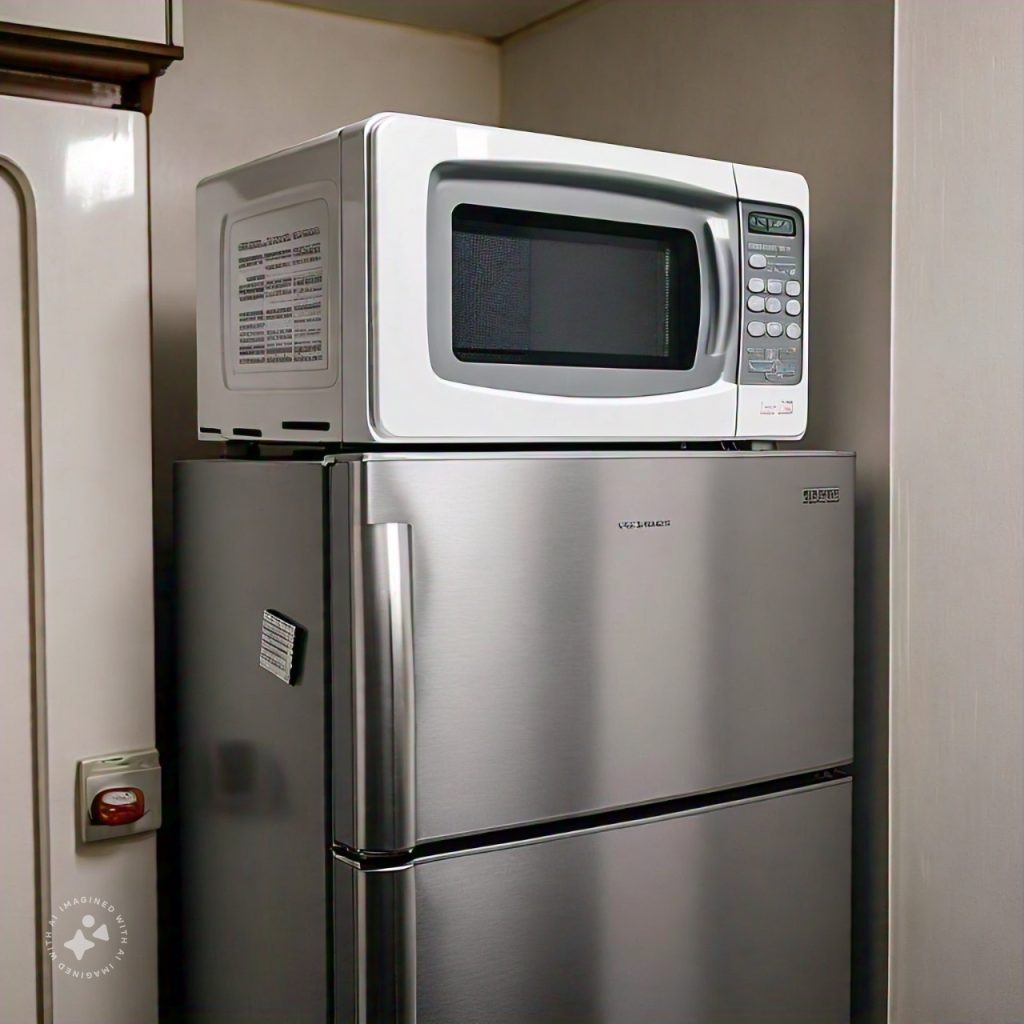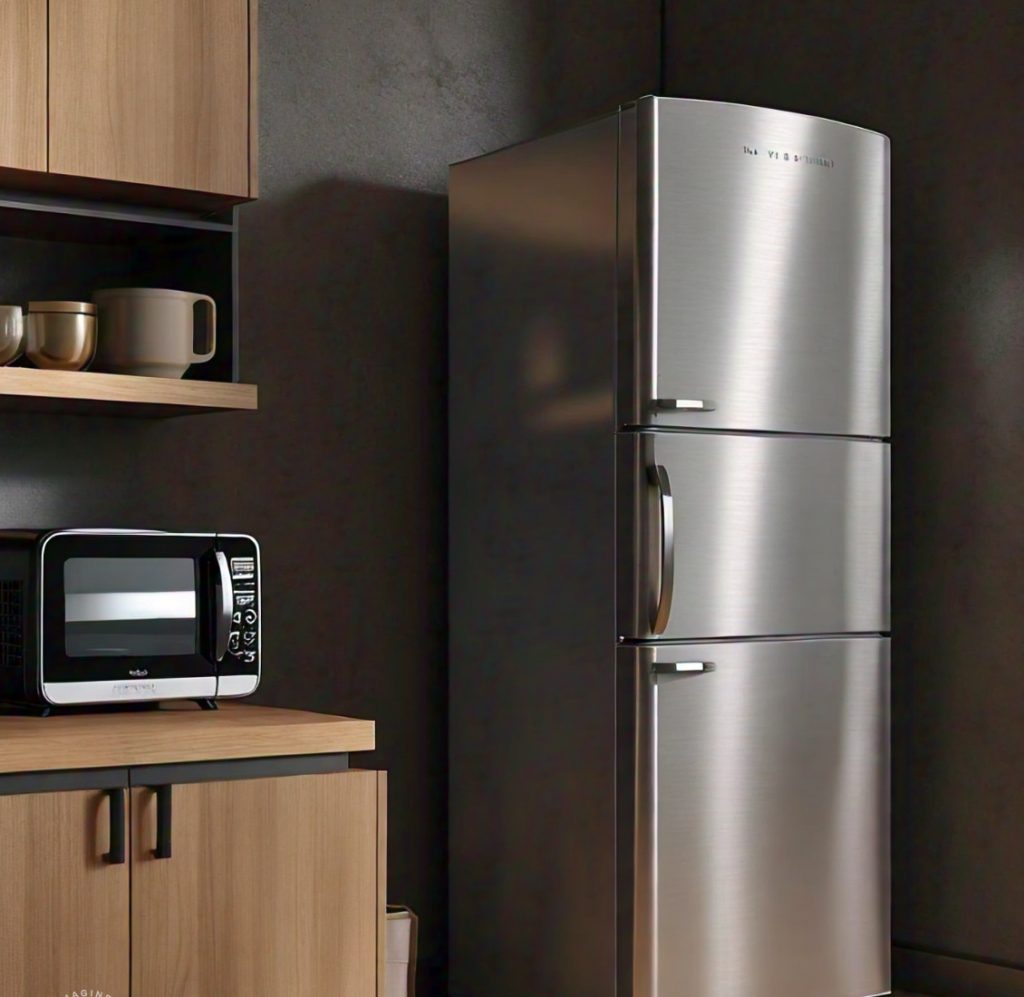A microwave is a common kitchen appliance that uses microwaves to heat food quickly and efficiently.
The question we’re addressing here is whether it’s acceptable or safe to place this appliance on top of a refrigerator.
In this article, we delve into the specifics of placing your microwave atop a fridge. We’ll discuss whether it’s feasible or not based on considerations such as stability, ventilation, and electrical safety among others. Additionally, if this setup isn’t advisable, we will explore alternative locations for microwaving in your home along with relevant tips and precautions you ought to be aware of. Frequently asked questions surrounding this topic will also be addressed to provide comprehensive insight on the matter.
Check out if any microwaved can be mounted under a cabinet.

Jump To:
Is it Safe to Place a Microwave on Top of a Fridge?
Yes, you can put a microwave on top of the fridge. However, it’s crucial to consider factors like stability of the refrigerator, ventilation and accessibility when placing your microwave oven there. Similar appliances like toaster ovens also require careful placement for safety reasons. Stability is important because microwaves can be heavy and may cause tip-overs if the fridge is unstable. Ventilation ensures that both appliances don’t overheat while accessibility means you won’t risk dropping anything hot.
Check out if a built-in microwave be placed on a countertop.
Facts about Putting Microwave on Top of Fridge
Here, we will discuss the important things to note about placing a microwave on top of a fridge.
- Heat Generation: Both microwaves and fridges generate heat. Microwaves produce heat when in use while refrigerators give off heat from their backs or bottoms as they cool down.
- Vibration: Refrigerators vibrate slightly when running, which could potentially cause a microwave placed on top to move or slide over time.
- Airflow: Microwaves need sufficient airflow around them for proper cooling. Placing it atop a refrigerator may restrict this necessary ventilation.
- Magnetic Interference: There’s potential for electromagnetic interference between the two appliances which can affect their performance.
- Safety Concerns: Reaching up to use the microwave can be inconvenient at best and dangerous at worst, depending upon your height and strength.
We have highlighted some key points concerning putting a microwave on top of the fridge.
Now let’s delve into more aspects related to microwaving practices with your appliance positions.
What are the Alternatives to Microwaving?
The safest practices for heating food without using a microwave include using an oven, stovetop cooking or induction cooking methods. These alternatives not only ensure safety but also prolong appliance lifespan by reducing risk of overheating from stacking appliances like fridges and microwaves.
Check out if you can put a regular microwave over the stove.
Tips for Microwaving
To effectively use your microwave while ensuring longevity:
- Never place it on top of another appliance such as a refrigerator.
- Ensure it is placed in well-ventilated area with enough space around it.
- Avoid running the microwave empty as this could lead its damage.
- Clean your microwave regularly to prevent build-up that can cause fires.
- Lastly, never heat non-microwave safe containers or metal items which could spark and cause fires or explosions within your unit.
In summary, placing a microwave on top of a fridge poses several risks including potential fire hazards due to overheating.
Now we will discuss FAQs in the next section.

Frequently Asked Questions (FAQs)
We will now look at the most commonly asked questions related to microwaving and heating.
Can you put a microwave on top of a fridge?
Yes, you can put a microwave on top of a fridge. However, it is important to consider factors such as stability, ventilation, and access. The top of the fridge should be flat and sturdy enough to hold the weight of the microwave. There should also be sufficient space for heat dissipation from both appliances. Lastly, the placement should allow for easy access without straining your body.
Should microwaves be placed near other appliances?
No, microwaves shouldn’t ideally be placed near other electrical appliances. This can cause interference with their operation due to electromagnetic waves emitted by microwaves during heating processes. Therefore, they are better kept separate or at least with some distance in between if possible for optimal performance.
Is it safe to heat foods in plastic containers in a microwave?
You can heat foods in plastic containers in a microwave only if they’re labelled microwave-safe. Some plastics may melt or leach harmful chemicals into food when heated hence it’s vital that you use only containers that carry this label when using them in a microwave.
Does frequent use of microwaves degrade their efficiency over time?
No direct correlation exists between frequent usage of a microwave oven and its degradation over time; however maintaining cleanliness and handling with care extends longevity significantly.
This concludes our frequently asked questions section about microwaving and heating.
Final Word
Microwave ovens have become an essential part of our kitchens aiding us greatly with their quick heating capabilities yet it’s important to understand their correct use to avoid any possible mishaps. Taking into account factors such as where you’re placing them, what containers you’re using in them and how often you’re cleaning them can ensure both the safety and longevity of your microwave oven.



